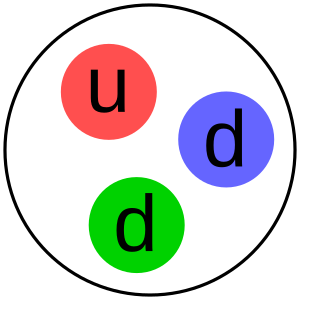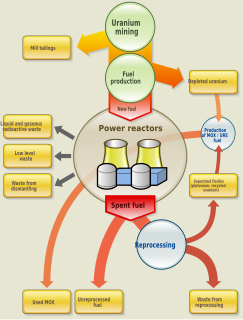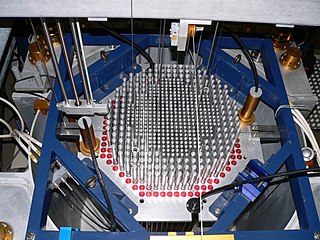
A nuclear reactor, formerly known as an atomic pile, is a device used to initiate and control a self-sustained nuclear chain reaction. Nuclear reactors are used at nuclear power plants for electricity generation and in nuclear marine propulsion. Heat from nuclear fission is passed to a working fluid, which in turn runs through steam turbines. These either drive a ship's propellers or turn electrical generators' shafts. Nuclear generated steam in principle can be used for industrial process heat or for district heating. Some reactors are used to produce isotopes for medical and industrial use, or for production of weapons-grade plutonium. Research reactors are run only for research. As of early 2019, the IAEA reports there are 454 nuclear power reactors and 226 nuclear research reactors in operation around the world.

Nuclear power is the use of nuclear reactions that release nuclear energy to generate heat, which most frequently is then used in steam turbines to produce electricity in a nuclear power plant. As a nuclear technology, nuclear power can be obtained from nuclear fission, nuclear decay and nuclear fusion reactions.
Presently, the vast majority of electricity from nuclear power is produced by nuclear fission of uranium and plutonium.
Nuclear decay processes are used in niche applications such as radioisotope thermoelectric generators.
Generating electricity from fusion power remains at the focus of international research.
This article mostly deals with nuclear fission power for electricity generation.
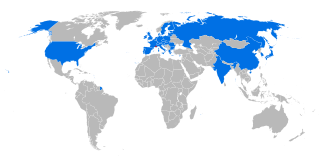
ITER is an international nuclear fusion research and engineering megaproject, which will be the world's largest magnetic confinement plasma physics experiment. It is an experimental tokamak nuclear fusion reactor that is being built next to the Cadarache facility in Saint-Paul-lès-Durance, in Provence, southern France.
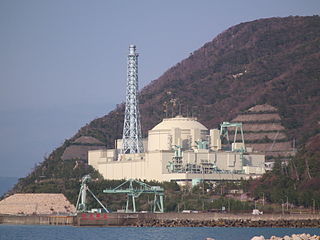
Monju (もんじゅ) is a Japanese sodium-cooled fast reactor, located in Tsuruga Nuclear Power Plant, Fukui Prefecture. Its name is a reference to Manjusri.

Fugen ふげん (Fugen) was a prototype Japanese nuclear test reactor.
Fugen was a domestic Japanese design for a demonstration Advanced Thermal Reactor. It was a heavy water moderated, boiling light water cooled reactor.
The reactor was started in 1979 and shut down in 2003. As of 2018, it is undergoing decommissioning.
It is located in Myōjin-chō, in the city of Tsuruga, Fukui.
The name "Fugen" is derived from Fugen Bosatsu (Samantabhadra), a Buddhist deity.

A molten salt reactor (MSR) is a class of nuclear fission reactor in which the primary nuclear reactor coolant and/or the fuel is a molten salt mixture. MSRs offer multiple advantages over conventional nuclear power plants, although for historical reasons, they have not been deployed.
Template:Infobox organizations
The Bhabha Atomic Research Centre (BARC) is India's premier nuclear research facility, headquartered in Trombay, Mumbai, Maharashtra. BARC is a multi-disciplinary research centre with extensive infrastructure for advanced research and development covering the entire spectrum of nuclear science, engineering and related areas.
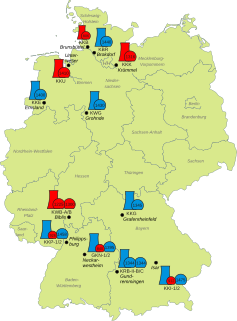
Nuclear energy policy is a national and international policy concerning some or all aspects of nuclear energy and the nuclear fuel cycle, such as uranium mining, ore concentration, conversion, enrichment for nuclear fuel, generating electricity by nuclear power, storing and reprocessing spent nuclear fuel, and disposal of radioactive waste.

Prior to the 2011 Tōhoku earthquake and tsunami, Japan had generated 30% of its electrical power from nuclear reactors and planned to increase that share to 40%. Nuclear power energy was a national strategic priority in Japan.
As of February 2019, there are 42 operable reactors in Japan.
Of these, 9 reactors in 5 power plants are operating.

Nuclear safety is defined by the International Atomic Energy Agency (IAEA) as "The achievement of proper operating conditions, prevention of accidents or mitigation of accident consequences, resulting in protection of workers, the public and the environment from undue radiation hazards". The IAEA defines nuclear security as "The prevention and detection of and response to, theft, sabotage, unauthorized access, illegal transfer or other malicious acts involving nuclear material, other radioactive substances or their associated facilities".

As of 2017, nuclear power in Pakistan is provided by 5 commercial nuclear power plants. Pakistan is the first Muslim country in the world to construct and operate civil nuclear power plants. The Pakistan Atomic Energy Commission (PAEC), the scientific and nuclear governmental agency, is solely responsible for operating these power plants.
As of 2012, the electricity generated by commercial nuclear power plants constitutes roughly ~3.6% of electricity generated in Pakistan, compared to ~62% from fossil fuel, ~33% from hydroelectric power and ~0.3% from coal electricity. Pakistan is not a party to the Nuclear Non-Proliferation Treaty but is a member of the International Atomic Energy Agency. Pakistan plans on constructing 32 nuclear power plants by 2050.

Science and technology in Japan is mostly focused and prominent in consumer electronics, robotics and the film industry.

The Mihama Nuclear Power Plant is operated by The Kansai Electric Power Company, Inc. and is in the town of Mihama, Fukui Prefecture, about 320 km west of Tokyo. It is on a site that is 520,000 m2 of which 60% is green space. Mihama - 1 was commissioned in 1970.

Nuclear power is the fifth-largest source of electricity in India after coal, gas, hydroelectricity and wind power. As of March 2018, India has 22 nuclear reactors in operation in 7 nuclear power plants, having a total installed capacity of 6,780 MW. Nuclear power produced a total of 35 TWh and supplied 3.22% of Indian electricity in 2017. 7 more reactors are under construction with a combined generation capacity of 4,300 MW.

Atomics International was a division of the North American Aviation company which engaged principally in the early development of nuclear technology and nuclear reactors for both commercial and government applications. Atomics International was responsible for a number of accomplishments relating to nuclear energy: design, construction and operation of the first nuclear reactor in California (1952), the first nuclear reactor to produce power for a commercial power grid in the United States (1957) and the first nuclear reactor launched into outer space by the United States (1965).

The China Experimental Fast Reactor (CEFR) is China's first fast nuclear reactor, and is located outside Beijing at the China Institute of Atomic Energy.
It aims to provide China with fast-reactor design, construction, and operational experience, and will be a key facility for testing and researching components and materials to be used in subsequent fast reactors.
The reactor achieved first criticality on July 21, 2010
and started generating power a year later on July 21, 2011.
On October 2012 Xinhua announced that the CEFR has passed official checks.
The CEFR was brought to full power at 5.00pm on 15 December 2014 and operated at this level continuously for three full days.
National nuclear energy policy is a national policy concerning some or all aspects of nuclear energy, such as mining for nuclear fuel, extraction and processing of nuclear fuel from the ore, generating electricity by nuclear power, enriching and storing spent nuclear fuel and nuclear fuel reprocessing. Nuclear energy policies often include the regulation of energy use and standards relating to the nuclear fuel cycle.

The Fukushima Daiichi nuclear disaster was an energy accident at the Fukushima Daiichi Nuclear Power Plant in Ōkuma, Fukushima Prefecture, initiated primarily by the tsunami following the Tōhoku earthquake on 11 March 2011. Immediately after the earthquake, the active reactors automatically shut down their sustained fission reactions. However, the ensuing tsunami disabled the emergency generators that would have provided power to control and operate the pumps necessary to cool the reactors. The insufficient cooling led to three nuclear meltdowns, hydrogen-air explosions, and the release of radioactive material in Units 1, 2 and 3 from 12 to 15 March. Loss of cooling also raised concerns over the recently loaded spent fuel pool of Reactor 4, which increased in temperature on 15 March due to the decay heat from the freshly added spent fuel rods but did not boil down to exposure.

